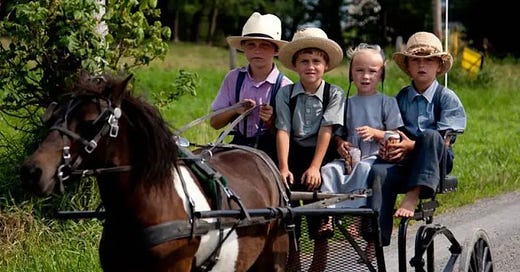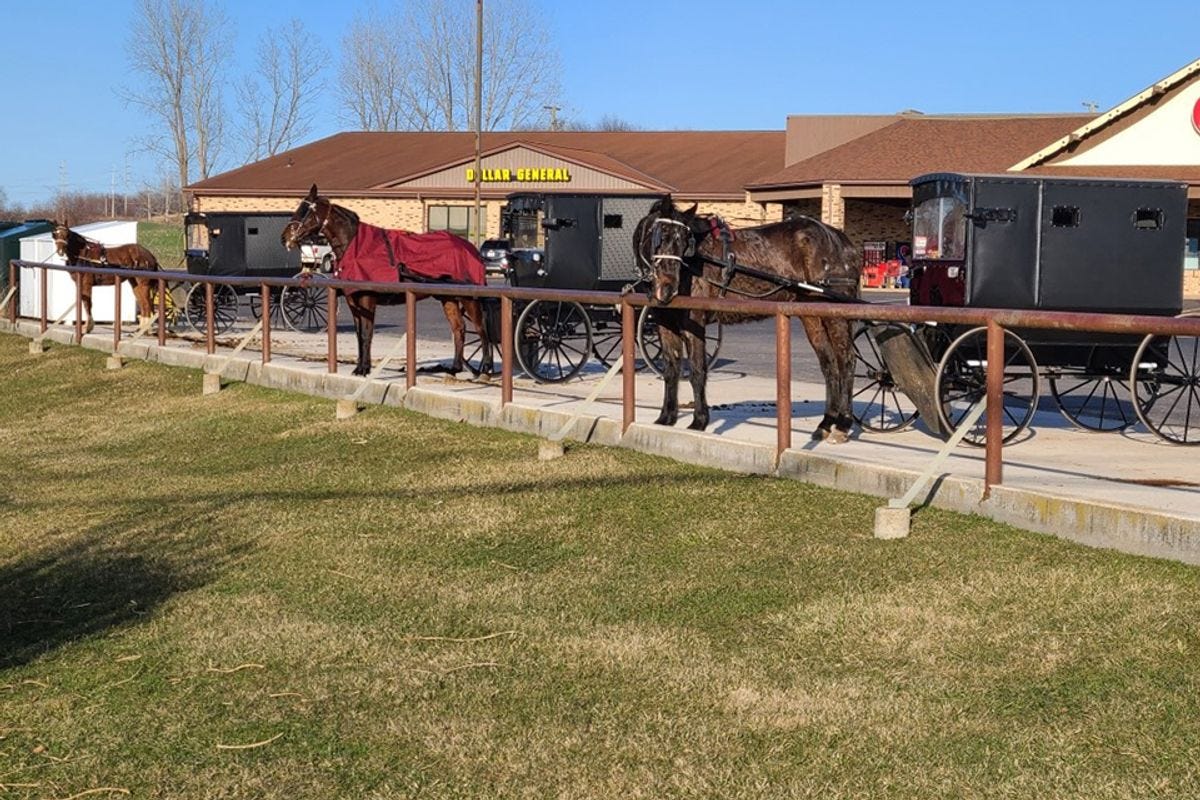New Study Finds Zero Amish Children Diagnosed with Cancer, Diabetes or Autism
90% had Covid with excess mortality detected in 2020
New Study Finds Zero Amish Children Diagnosed with Cancer, Diabetes or Autism
A new comprehensive study has found that no Amish children have been diagnosed with chronic conditions, which widely impact the rest of America.
In a new comprehensive study, presented by VSRF founder Steve Kirsch to the Pennsylvania State Senate, it was calculated that for Amish children, who are strictly 100 percent unvaccinated, typical chronic conditions barely exist, if any at all.
Across America, the current population of Amish people is quickly approaching 400,000.
The largest concentrations of Amish citizens are 90,000 in Pennsylvania and 82,000 in Ohio.
Amish communities have settled in as many as 32 U.S. states.
Families have an average of 7 kids so the Amish population is growing rapidly.
The Amish are a group of traditionalist Christians who are known for simple living, plain dress, and Christian pacifism.
They reject most conveniences of modern technology and pharmaceuticals and maintain self-sufficiency.
The Amish value rural life, manual labor, humility, and Gelassenheit (submission to God’s will) with a view neither to interrupt family time nor replace face-to-face conversations whenever possible.
Yet, despite rejecting all modern medicine and pharmaceutical drugs that the rest of the American people have access to, the Amish are among the healthiest in the nation.
As we recently reported, a study conducted by the Vaccine Safety Research Foundation (VSRF) found that Covid death rates among Amish communities are 90 times lower than for the rest of America.
The main difference, the study revealed, is that Amish communities completely ignored the guidelines from the U.S. Centers for Disease Control and Prevention (CDC).
Amish families did not get vaccinated or wear masks, nor did they engage in lockdowns, social distancing, or any other type of restrictions.
But the separated communities didn’t avoid catching the virus, however, as roughly 90% of the Amish have been infected with Covid.
These chronic conditions, which many vaccinated children and swaths of Americans suffer from, include auto-immune disease, heart disease, diabetes, asthma, ADHD, arthritis, cancer, and autism.
During testimony before the PA Senate, expert health advocates shared details on why there have never been any reports published regarding the health of Amish children in general.
“After decades of studying the Amish, there’s no report because the report would be devastating to the narrative,” Kirsch testified.
“It would show that the CDC has been harming the public for decades and saying nothing and burying all the data.”
Leading American cardiologist, and friend of Leading Report’s, Dr. Peter McCullough has dozens of peer-reviewed published works related to the rise of chronic conditions among the public.
McCullough has testified before the U.S. Senate and before legislatures throughout the U.S. regarding the dangers of mRNA jabs.
Kirsch and McCullough joined top attorney Thomas Renz and medicolegal death investigator Graham Hetrick on a panel of experts who testified before the Pennsylvania State Senate.
The experts all noted that chronic conditions are soaring among the American people.
However, they concluded that these conditions are non-existent among unvaxxed Amish communities.
According to the VSRF study, not one single Amish child could be found who had suffered from cancer, autism, heart disease, or other conditions that are on the rise among American children.
Death and religion: ‘Excess deaths’ sweep through Amish and Mennonite communities during COVID-19 pandemic
Tuesday, June 22, 2021
New research from WVU sociologists suggests that the Amish population saw “excess deaths” in 2020 in the midst of the COVID-19 pandemic. Researchers theorize their distrust in preventative medicine and history of religious persecution played a role in the death spike. (Courtesy Photo/ Ben Stein)
Sunday church service in Amish country is more than just belting out hymns, reading Bible passages and returning home an hour later to catch a football game or nap.
It’s an all-day affair: A host family welcomes church members - between 20 to 40 families - into their home to worship and have fellowship with one another from morning to night. Church is a biweekly activity; each gathering takes place in a member’s home and is a key ritual in the Amish community which values in-person communication.
New research from West Virginia University sociologists suggests this face-to-face interaction, coupled with a distrust in preventative medicine, led to “excess deaths” among the Amish population in 2020.
The death rate for that year soared above the baseline average from 2015 to 2019, with the largest spike – 125% - occurring in November.
Researchers, led by Rachel Stein, associate professor of sociology, analyzed obituary information published in an Amish/Mennonite newspaper to examine excess death among this segment of the population in 2020. Their results are published in the Journal of Religion and Health.
“By taking multiple years of historical data, we can create an average rate of death,” explained co-author Katie Corcoran, associate professor of sociology. “For 2020, when the pandemic started, we identified how much extra deaths occurred on top of that average. We call that excess deaths.”
The team emphasized that these deaths may or may not be directly related to COVID-19; however, the excess death rates among the Amish/Mennonites mirrored the general COVID-19 infection waves in the United States. Researchers did not access official death certificates (which do not indicate religion/faith) and obituaries usually lacked the cause of death.
Information was taken from The Budget, a weekly correspondence newspaper published in Ohio geared toward the Amish and Mennonite communities.
Stein, who grew up in Amish country, decided to explore COVID-19’s impacts after noticing many community members not practicing social distancing at the onset of the pandemic. Also, the Amish do not use modern technology, such as electricity, and tend to distrust preventative medicine, lifestyle choices engrained in their culture and religion.
“There's been a lot of minimizing of the severity of COVID,” Stein said. “There's a perception that COVID is like the flu. If people get sick, then people get sick and will eventually get over it.
“I don’t want to convey that all Amish aren’t taking COVID seriously. That’s not true. There are certainly groups of Amish who perceive COVID as a real problem and they’ve had loved ones negatively affected by it.”
God’s law beats man’s law
Co-author Corey Colyer, associate professor of sociology, views the team’s findings through the intersection of religion and government guidelines.
Colyer believes that policies established by government entities can leave behind a bad taste for members of religious communities bearing a history of persecution.
“Mandates prohibiting church can backfire,” Colyer said. “We’ve picked up on that in letters to The Budget. The Amish, conservative Mennonites and other Anabaptists have collective memories of persecution.”
Colyer explained that when the Anabaptists formed in the Counter-Reformation, they were heavily persecuted and even rounded up and executed in Europe.
“When this pandemic hit and the state prohibited worship, they didn’t take it lightly,” Colyer said. “They don’t look at it as a ‘nanny state’ or a government overstepping its bounds. They take it as persecution. Any attempt to curtail religious gathering and practice interferes with their sacred business.
“When states step in and say, ‘You can't gather for Church,’ they say, ‘Well, there’s man law and there’s God’s law. We’re going to follow God’s law.’”
The study suggests that, in general, many groups complied with government guidelines limiting religious gatherings in March and April. But many resumed church services by summer.
When government restrictions relaxed more so in the fall in Ohio, that’s when researchers observed the greatest spike in excess deaths.
The coming days, weeks and months will remain problematic from a public health standpoint in these communities, as most members will not practice social distancing or get vaccinated, the research team said.
Researchers stressed that the Amish should not be singled out. Their methodology could be applied in studying other religious groups and the impacts of COVID-19. They noted that in some countries, such as Egypt and Jordan, Muslim and Christian obituaries are clearly distinguishable. There are also Jewish newspapers across the United States and the world that report obituaries. An unrelated study (Connelly, 2020) showed how COVID-19 decimated a Jewish community.
At the end of the day, all human beings, regardless of race, religion or creed, can succumb to the virus.
“COVID does not respect doctrinal boundaries,” Colyer said. “Many of the Amish believe that God will protect them. The evidence suggests that COVID doesn't care if you are Amish or English, Christian or atheist. The consequences are the consequences.”
The study was funded by a $258,719 award from the National Science Foundation and earlier grants from the WVU Humanities Center, and the International Research Network for the Study and Science and Belief in Society.
Citation: Closed but Not Protected: Excess Deaths Among the Amish and Mennonites During the COVID‑19 Pandemic
According to the cited academic study, “Our results indicate the Amish/Mennonite excess death rates are similar to the national trends in the USA.” So all the church lockdowns and social distancing mandates that the Amish ignored and that the article kvetches about didn’t make a significant difference to excess mortality. The study also showed a significantly higher average age of death than baseline, suggesting there was a pull-forward effect.
Have a blessed day!






What's mind-blowing about the comment at the end by the researchers attempting to claim the Amish had just as many deaths, is the fact that the Amish didn't social distance and the rest of the world did and it didn't benefit the rest of the world at all then. They disprove their haughty attempt to claim the Amish suffered equally. If people die regardless and one community got to live happily and congregate and the other didn't, then who actually had it better? Sounds like a win for the Amish regardless of how they attempt to spin it.
Snopes will be all over this.